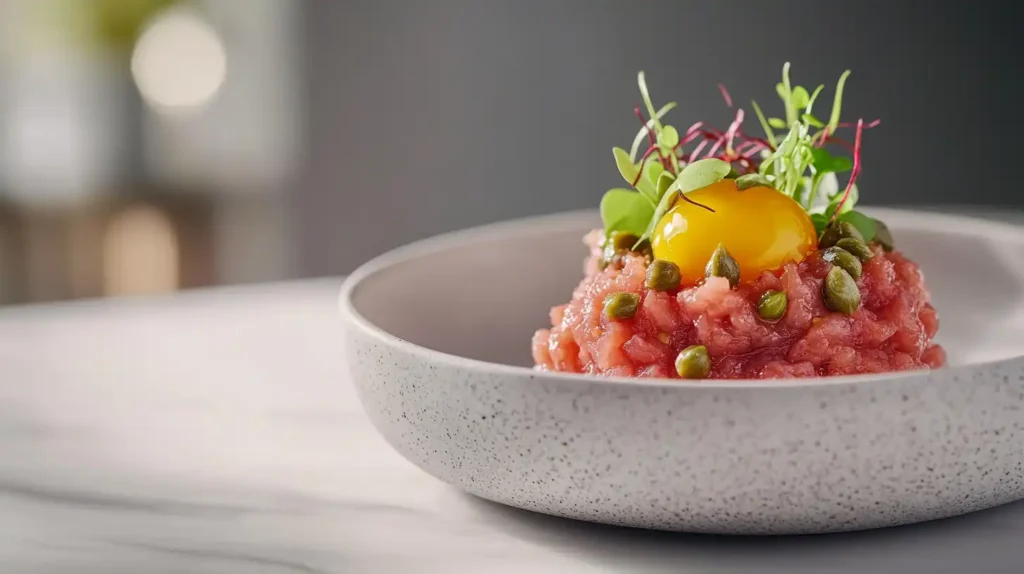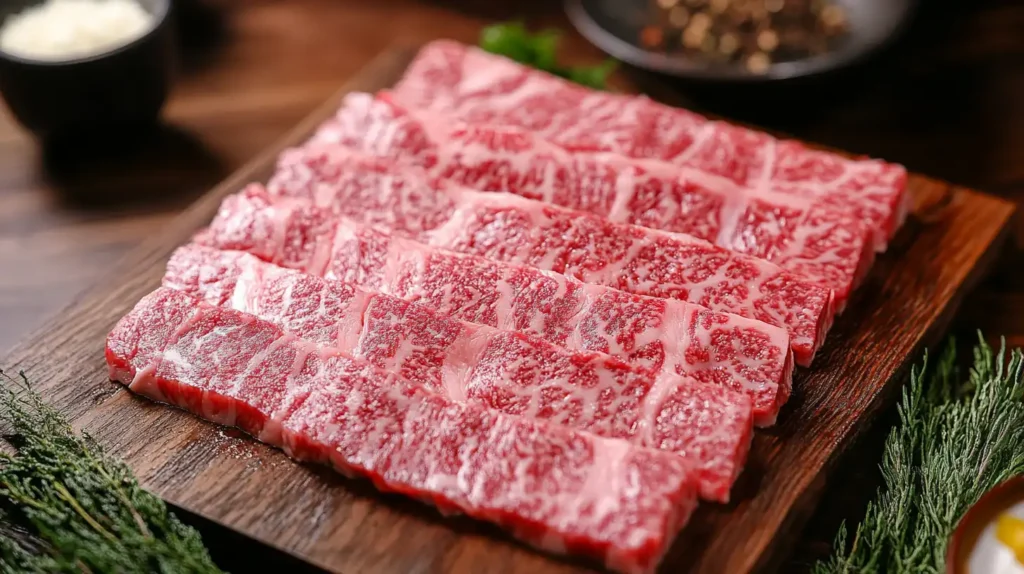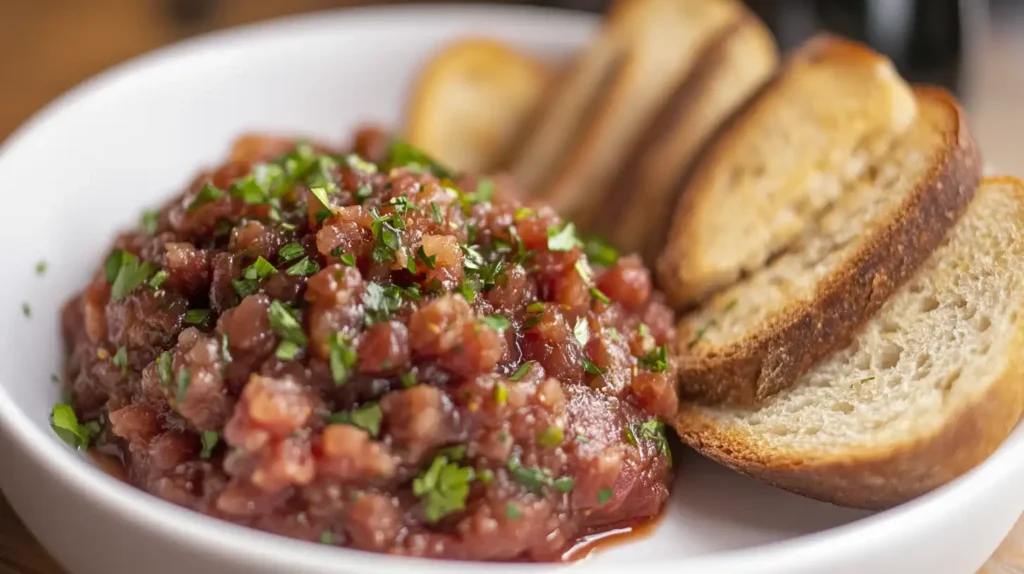What is Wagyu Beef Tartare?

Wagyu beef tartare is a luxurious and flavorful dish that showcases the exceptional quality and tenderness of Wagyu beef. This delicacy is made from finely chopped or minced raw Wagyu beef, often seasoned with spices, herbs, and condiments to enhance its natural richness. Known for its marbling and buttery texture, Wagyu beef elevates the tartare experience to a gourmet level, making it a favorite among food enthusiasts.
Typically served as an appetizer, Wagyu beef tartare is paired with accompaniments like crackers, toasted bread, or fresh greens. The dish’s visual appeal and melt-in-the-mouth sensation set it apart as a highlight in fine dining menus. Whether enjoyed at upscale restaurants or prepared at home, Wagyu beef tartare promises a unique combination of elegance and taste.
Understanding Wagyu Beef
Wagyu beef originates from Japan and is renowned worldwide for its exceptional quality, tenderness, and intense marbling. The term “Wagyu” translates to “Japanese cow,” and the beef is sourced from specific breeds such as the Japanese Black, Japanese Brown, and Japanese Shorthorn. These cattle are raised under strict guidelines to ensure their meat delivers a premium taste and texture.
What Makes Wagyu Special?
The defining characteristic of Wagyu beef is its high level of intramuscular fat, which appears as marbling throughout the meat. This marbling not only enhances flavor but also gives the beef its signature buttery texture, making it ideal for raw dishes like tartare.
In addition to its texture, Wagyu beef has a rich umami flavor, often described as savory and slightly sweet. These qualities make it a versatile ingredient, suitable for both raw preparations and cooked dishes.
Is Wagyu Beef Healthier?
Wagyu beef is often considered healthier than conventional beef due to its fat composition. While it is high in fat, most of this fat consists of monounsaturated fatty acids (MUFA), which are known to promote heart health. Wagyu beef is also rich in omega-3 and omega-6 fatty acids, which contribute to reducing inflammation and improving cholesterol levels.
Additionally, Wagyu beef provides high-quality protein, essential vitamins like B12, and minerals such as iron and zinc. When consumed in moderation, it can be part of a balanced diet without compromising health goals.
Why Use Wagyu Beef for Tartare?
Wagyu beef is an exceptional choice for tartare due to its superior flavor, texture, and quality. Unlike other types of beef, Wagyu’s marbling ensures a silky-smooth texture that melts in your mouth, making it perfect for raw preparations.
Is Wagyu Beef Good for Tartare?
Absolutely! Wagyu beef’s tenderness and rich flavor profile make it one of the best options for tartare. Its natural marbling adds moisture and taste, eliminating the need for excessive seasoning. Moreover, Wagyu beef is often sourced from trusted farms, ensuring high safety and quality standards, which are crucial when serving raw meat. For a deeper dive into nutritional comparisons, check out this article on Swordfish Meat and Its Health Benefits, which also highlights nutrient-rich protein options.
Choosing the Best Cut for Tartare
Selecting the right cut of Wagyu beef is essential for creating a delicious tartare. The best cuts are lean yet tender, providing a smooth texture without excessive fat.

What Cut of Beef is Best for Tartare?
For Wagyu beef tartare, the following cuts are highly recommended:
- Tenderloin: Known for its softness and mild flavor, making it ideal for raw dishes.
- Sirloin: Slightly more flavorful but still tender enough for tartare.
- Ribeye Cap: Offers extra marbling, adding depth to the flavor profile.
Choosing a high-grade Wagyu cut, such as A5, ensures the best results. These cuts balance marbling with tenderness, making them perfect for raw consumption.
Preparing Wagyu Beef Tartare
Creating Wagyu beef tartare requires precision and attention to detail to highlight the beef’s rich flavor and buttery texture. Here’s a step-by-step guide to preparing this gourmet dish:
- Choose High-Quality Wagyu Beef:
Opt for fresh, premium-grade Wagyu beef, preferably A5 or similar, ensuring it’s safe for raw consumption. - Chill the Beef Before Preparation:
Keep the meat chilled in the refrigerator before slicing. Cold meat is easier to cut finely and maintains freshness. - Trim Any Excess Fat or Connective Tissue:
Although Wagyu is naturally marbled, trim off any tough parts to maintain a smooth texture. - Finely Dice the Beef:
Use a sharp knife to cut the beef into small, even pieces rather than grinding it. Hand-cutting preserves texture and quality. - Season Carefully:
Enhance the beef with classic seasonings like salt, black pepper, Dijon mustard, capers, shallots, and Worcestershire sauce. Balance flavors without overpowering the meat’s natural taste. - Add Egg Yolk for Creaminess:
Top the tartare with a raw egg yolk, which adds richness and visual appeal. - Mix and Serve Immediately:
Combine ingredients gently and serve fresh to maintain flavor and safety. Accompany with toasted bread or crackers for added crunch.
Is Beef Tartare Made with Raw Beef?
Yes, beef tartare is traditionally made with raw beef, making ingredient quality and freshness critical. Wagyu beef is a popular choice because of its high-fat content, which prevents dryness and adds flavor.
When preparing raw beef dishes, it’s essential to follow safety guidelines:
- Use meat from trusted sources.
- Keep it chilled until serving.
- Avoid cross-contamination by using clean utensils and surfaces.
Consuming raw Wagyu beef is safe when proper handling and hygiene practices are followed.
Enhancing Flavor in Wagyu Beef Tartare
To elevate the taste of Wagyu beef tartare, focus on complementary flavors and textures. Here are some tips to enhance the dish:
- Acidic Elements: Add lemon juice, capers, or pickles for a tangy contrast to the beef’s richness.
- Herbs and Spices: Use chives, parsley, or tarragon for freshness, and incorporate black pepper or smoked paprika for depth.
- Savory Sauces: A drizzle of truffle oil or a touch of soy sauce can enhance umami flavors.
- Crisp Garnishes: Include fried shallots, radishes, or microgreens for texture and visual appeal.
Experimenting with flavors allows you to create a unique tartare while preserving the essence of Wagyu beef. Similar safety considerations apply to seafood dishes – learn more about safe raw preparations in What Does Swordfish Taste Like?
Variations of Wagyu Tartare Recipes
Wagyu beef tartare can be adapted to suit different palates and styles. Here are a few popular variations:
- Asian-Inspired Wagyu Tartare:
- Add sesame oil, ginger, scallions, and soy sauce for an umami-packed twist.
- Italian-Style Tartare:
- Incorporate Parmesan shavings, arugula, and a drizzle of balsamic glaze.
- Spicy Wagyu Tartare:
- Infuse heat with chili flakes, Sriracha, or horseradish for a bold flavor profile.
- Classic French Tartare:
- Stick to traditional ingredients like Dijon mustard, shallots, and egg yolk for timeless elegance.
Customizing your tartare allows you to showcase Wagyu beef’s versatility while appealing to different taste preferences.
Storing and Serving Wagyu Beef Tartare
Storage Tips:
- Short-Term Storage: Keep the beef chilled at or below 40°F (4°C) and prepare it as close to serving time as possible.
- Avoid Freezing: Freezing may alter the texture of Wagyu beef, making it less suitable for tartare.
For a complementary breakfast dish, explore Chicken Biscuits and Gravy, another comfort-food favorite that works well alongside tartare for a luxurious brunch.
Serving Suggestions:

- Presentation Matters: Plate the tartare with precision, using a ring mold for a clean shape.
- Pair with Bread or Crackers: Toasted baguette slices or crisp crackers complement the creamy texture of the beef.
Beyond Tartare – Cooking Wagyu Beef
While Wagyu beef tartare is a delicacy, this premium meat also shines in cooked dishes.
How to Cook Wagyu Beef Burgers
Wagyu burgers are known for their juiciness and flavor. Follow these steps for the perfect burger:
- Shape Patties Gently: Form loose patties without overworking the meat to retain tenderness.
- Season Simply: Use salt and pepper to let the meat’s flavor stand out.
- Cook Over Medium Heat: Avoid high heat, which can dry out the beef. Grill or pan-sear for 3–4 minutes per side.
- Rest Before Serving: Let the burgers rest for a few minutes to redistribute juices.
How to Cook Wagyu Beef
For steaks or roasts, cooking Wagyu requires care:
- Bring to Room Temperature: Allow the meat to rest at room temperature before cooking.
- Use Minimal Seasoning: Salt and pepper are often enough to highlight the flavor.
- Sear Quickly: Cook over high heat to form a crust, then lower the heat to finish cooking.
- Rest Before Cutting: Let the beef sit for 5–10 minutes to preserve its juices.
Cooking Wagyu beef enhances its buttery texture and makes it perfect for diverse dishes beyond tartare.
Health Considerations of Wagyu Beef
Wagyu beef is often regarded as a healthier option compared to conventional beef due to its unique fat composition and nutritional benefits.
Nutritional Profile of Wagyu Beef
- Rich in Monounsaturated Fats (MUFA): These heart-healthy fats can help reduce bad cholesterol levels while boosting good cholesterol.
- Omega-3 and Omega-6 Fatty Acids: Wagyu beef contains higher levels of these essential fatty acids, which support cardiovascular health and reduce inflammation.
- High-Quality Protein: It provides essential amino acids necessary for muscle growth, repair, and overall body function.
- Vitamin and Mineral Content: Wagyu beef is a source of vitamin B12, zinc, and iron, which are vital for red blood cell production and energy metabolism.
Portion Control and Moderation
Although Wagyu beef is nutrient-rich, it’s calorie-dense due to its marbling. Consuming it in moderate portions ensures that you enjoy its benefits without overloading on fat or calories.
Is Wagyu Beef Healthier?
Yes, Wagyu beef is often considered healthier than regular beef because of its balanced fat profile. Its higher percentage of unsaturated fats makes it a better choice for heart health. However, like any red meat, it’s best enjoyed in moderation as part of a balanced diet.
FAQs
Can Wagyu Beef Be Eaten Raw?
Yes, Wagyu beef can be eaten raw, especially when prepared as tartare. However, it’s essential to ensure that the beef is sourced from a reputable supplier, stored properly, and handled with care to prevent contamination. Always use fresh, high-grade Wagyu beef labeled safe for raw consumption.
Is Wagyu Beef Healthy?
Wagyu beef is healthy when eaten in moderation. Its high levels of monounsaturated fats, omega fatty acids, and essential nutrients make it a nutritious choice. However, because it’s rich in fat, portion control is key to maintaining a balanced diet.
What to Make with Wagyu Ground Beef?
Wagyu ground beef is versatile and can be used in several dishes, including:
- Wagyu Burgers: Juicy and flavorful patties cooked to perfection.
- Meatballs: Tender and rich meatballs paired with pasta or sauces.
- Stuffed Peppers: A hearty and satisfying meal option.
- Tacos or Sliders: Perfect for gatherings and quick meals.
- Wagyu Chili: A comforting dish packed with flavor and spice.
Whether grilled, baked, or slow-cooked, Wagyu ground beef enhances the taste of any dish. For seafood lovers, pairing with Swordfish Dishes can create a balanced surf-and-turf menu.
Conclusion
Wagyu beef tartare stands out as a luxurious, flavorful dish that highlights the premium quality of Wagyu beef. With its rich marbling, buttery texture, and high nutritional value, it’s no surprise that Wagyu tartare has become a staple in gourmet cuisine. Whether you’re enjoying it as a starter or experimenting with variations, this dish offers a unique culinary experience.
Beyond tartare, Wagyu beef’s versatility makes it ideal for burgers, steaks, and other dishes, offering endless possibilities for cooking enthusiasts. While Wagyu is nutrient-rich and packed with heart-healthy fats, it’s best enjoyed in moderation to balance flavor and health.
By following proper preparation and safety guidelines, you can confidently serve Wagyu beef tartare and impress your guests with this sophisticated delicacy. Whether raw or cooked, Wagyu beef continues to set the standard for excellence in the culinary world.
